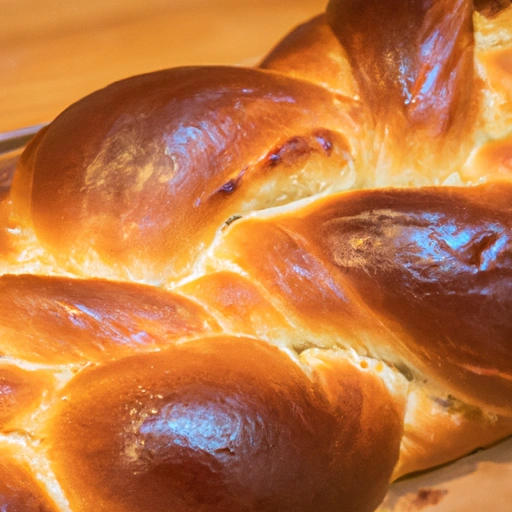Challah
Description

Challah is a traditional Jewish bread known for its beautifully braided design and rich, slightly sweet flavor. This egg-enriched bread boasts a tender, chewy crumb and a golden crust, making it a beloved staple in many culinary traditions. Challah is typically made with simple ingredients including flour, eggs, water, yeast, sugar, and salt, with some variations incorporating oil, honey, or seeds for additional flavor.
Common uses
Challah is a versatile bread that can be used in a range of culinary applications. It is a staple at many Jewish ceremonial occasions, especially the Sabbath and holidays such as Rosh Hashanah, when it is often shaped into rounds to symbolize the cycle of the year. Additionally, challah can be enjoyed in everyday meals, either plain or adorned with toppings such as poppy seeds, sesame seeds, or everything bagel seasoning.
Nutritional value
Calories
A typical serving of challah (about 1/16 of a loaf or 2 oz / 57 g) contains approximately 160-200 calories.
Protein
Challah provides about 5-6 grams of protein per serving.
Fat
Challah contains around 2-4 grams of fat per serving, depending on the specific recipe and whether additional fats are used.
Carbohydrates
The carbohydrate content of challah is roughly 30-35 grams per serving.
Vitamins
As an egg-enriched bread, challah offers a source of B-vitamins, particularly B12 and riboflavin.
Minerals
Challah also provides minerals such as iron, selenium, and zinc, thanks to the flour and eggs used in its preparation.
Health benefits
Challah, when consumed in moderation, can be part of a balanced diet. The eggs in challah contribute to its protein content, making it a more satisfying bread choice. Additionally, the B-vitamins present in challah support energy metabolism and brain health.
Potential risks
Despite its nutritional benefits, challah is a calorie-dense food and can contribute to weight gain if consumed in large quantities. It is also high in carbohydrates, which should be monitored by individuals with blood sugar control issues. Moreover, as challah contains gluten, it is not suitable for those with celiac disease or gluten intolerance.
Common recipes
Challah is most commonly used in traditional Jewish recipes such as Sabbath and holiday meals. It can be sliced and served with dips or spreads, used as a base for French toast, or turned into breadcrumbs for kugels and stuffing.
Cooking methods
The classic method of preparing challah involves braiding the dough, which is then baked until it achieves a golden-brown crust. The braiding can be simple or complex, ranging from a three-strand braid to intricate multiple-strand designs and shapes.
Pairing with other ingredients
Challah pairs beautifully with both sweet and savory accompaniments. It complements dishes such as soups and salads and can be an excellent base for sandwiches. For sweeter options, challah can be used in bread pudding, paired with jams, or topped with honey or chocolate spread.
Summary
Challah is a distinctive and delectable bread that holds a prominent place in Jewish culinary traditions, yet has gained popularity across the globe for its versatility and delightful taste. Whether enjoyed on ceremonial occasions or incorporated into everyday meals, challah's rich history and nutritional profile make it a noteworthy addition to any table.